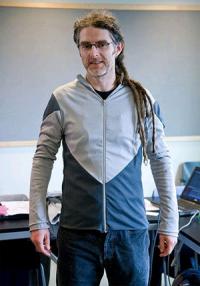 COSMOS Magazine has a round-up of the current state-of-play in the nascent field of digital scent reproduction. We can do some pretty impressive stuff with digital media for our eyes and ears, and research into haptic technology seems to be ramping up in order to conquer the heretofore neglected sense of touch, but smell is a tricky proposition, because it’s a chemical process. But one Jenny Tillotson of London’s University of Arts seems to be making some advances:
COSMOS Magazine has a round-up of the current state-of-play in the nascent field of digital scent reproduction. We can do some pretty impressive stuff with digital media for our eyes and ears, and research into haptic technology seems to be ramping up in order to conquer the heretofore neglected sense of touch, but smell is a tricky proposition, because it’s a chemical process. But one Jenny Tillotson of London’s University of Arts seems to be making some advances:
Her newest gadget is the button-sized ‘eScent’. It contains bio-sensors that monitor changes in the blood pressure, respiration and skin’s electric potential. When it detects a change, it sends signals to the lab-on-a-chip devices, which then change the type or intensity of fragrance released.
Though currently crude at detecting more subtle mood changes, the idea is that eScent will eventually be able to detect stress or anxiety and then release appropriate scents to soothe the wearer. “I’m more interested in health aspects linked to aromachology, the science of fragrance, rather than just a gimmicky scent delivery system that substitutes the perfume bottle,” Tillotson says.
There is evidence to show that there is a direct link between the sense of smell and human health and well-being. “Three quarters of the emotions that we generate on a daily basis are affected by smell,” she says. “Certain odours can also relieve side effects from chemotherapy, or significantly benefit people who suffer from insomnia, muscle stiffness, bronchitis, poor concentration, indigestion, and high-blood pressure.”
Therapeutic uses are all well and good, but Tillotson’s earlier “Smart Second Skin” system strikes me as the more likely deployment to be taken up by well-moneyed early adopters, combining as it does high fashion with high technology:
Smart Second Skin combines lab-on-chip technology with miniature bio-sensors. Lab-on-chip allows the storage and handling of tiny amounts of fluids on small chips. These chips can be programmed to release specific scents at specific times.
“Just as people store different genres of music on their iPods, this method offers a new sensory system to collect and store a selection of fragrances close to the body: a modern iPod of the fragrance industry embedded in fashion” Tillotson says.
Looking further down the line, aromachology may well become another facet of immersive virtual and/or augmented reality systems, and perhaps to some user interfaces in applicable industries; it’s well known that the sense of smell is deeply linked to human memory, and so it might add an extra dimension to simulated environments… as well as offering new avenues for psychological therapies.
But it’s a double-edged sword: supermarkets and large corporate offices are already well aware that certain smells – freshly baked bread or apples, for example – can influence behaviour. What sort of tricks might they learn to pull when any smell can be synthesised at short order in direct response to physiological triggers? [image by me and the sysop]
 Science writer
Science writer  Researchers at the LGC Chemical Metrology Laboratory and the University of Oviedo in Spain have developed
Researchers at the LGC Chemical Metrology Laboratory and the University of Oviedo in Spain have developed  Wonderful haptic jacket being developed at Phillips Electronics,
Wonderful haptic jacket being developed at Phillips Electronics,  Apparently for real
Apparently for real